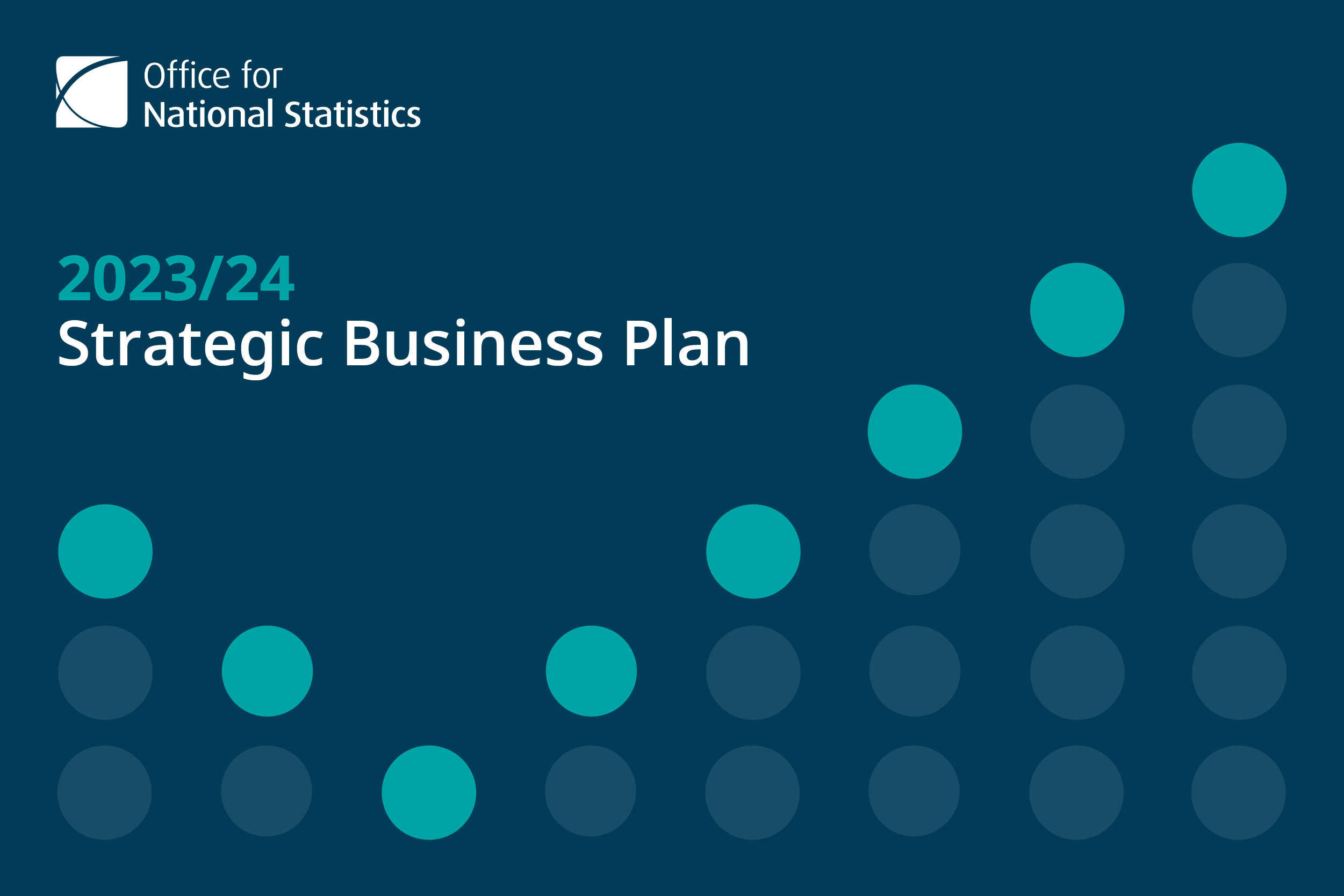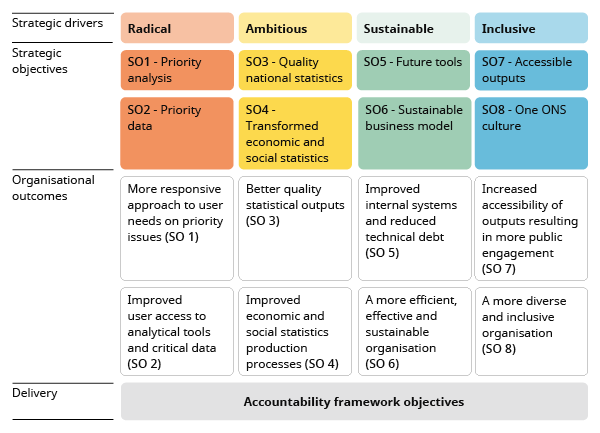How we align with the UKSA Strategy
The Office for National Statistics (ONS) is the executive office of the UK Statistics Authority (UKSA), meaning ONS shares the UKSA mission statement and strategy, Statistics for the Public Good. The ONS Strategic Business Plan sets out how we fully align and contribute to the achievement of the UKSA strategy.
The UKSA strategy has four strategic drivers (also known as ‘pillars’) that direct our work and delivery approaches, and these are explained in more detail below. The strategic objectives provide the link between the strategy (the drivers) and the Strategic Business Plan (our work).
Back to topThe Four Strategic Drivers
The strategic drivers that direct and support the ONS’s contribution to the UKSA strategy are described below.
We will be radical in our drive for inclusive, cross-cutting analysis that support Government, civil society and the public understand the key questions of the day. To do so we will exploit radical approaches to data analysis, utilising leading-edge data science and methodological techniques, real-time data streams and AI to generate powerful insights to respond in an agile way to demand. We will form inclusive partnerships across Government, academia and civil society to ensure ongoing relevance to all our stakeholders, to harness the best expertise, and maintain our ability to pivot our response rapidly to new and emerging priorities, as demonstrated through the COVID-19 Infection Survey. Through the Integrated Data Service Programme, we will deliver the capability, processes and technology to support the integration of Government data and deliver and disseminate analysis that cuts across organisational and societal boundaries.
We will deliver relevant and timely reference statistics at pace with a relentless drive for quality and inclusion that reflect the population, society, economy and environment we live in today, including high-quality outputs from the Census 2021. We will drive forward improvements to our outputs, data collection and data sharing across government (both legislative and policy), reducing friction and expediting access whilst ensuring our data principles are upheld. We will deliver ever more timely and granular economic and social statistics – flexing capacity across data science and analysis to meet government’s data needs. We will deploy industry leading technology and tools to enhance our productivity and collaborative working, building a working environment that retains and attracts the best talent. We will transform how we present data to provide quick and easy access to all users through the web development programme.
We will ensure that the data we collect and outputs we produce reflect all sectors and groups of the economy and every member of society, acting on the recommendations from the Inclusive Data Task Force. We will embed inclusivity in all our policies, practices, and outputs to ensure our statistics and analysis reflect the diversity of the economy and society in which we live and are fully accessible. Our colleagues and partnerships will be representative of the society we live in, supportive of the wellbeing of our workforce and inclusive by design in line with the principles of our People Plan.
We will deliver key data in support of the net zero agenda through our economic, social, and environmental statistics. We will pursue a continuous improvement approach through our efficiency framework to identify and deliver efficiencies that deliver more for less by simplifying, modernising and automating processes whilst reducing reliance on legacy systems and processes. We will consider the sustainability of all our activities in relation to finance, people, technology, and environmental factors, and develop a sustainable business model that integrates lessons from the COVID-19 pandemic. This will include aligning our resources to activities and programmes where we are uniquely placed to deliver, and that have the highest impact on our strategic priorities.
Strategic Objectives
We developed a set of Strategic Objectives to provide the key link between the Strategy and our plans whilst being sustainable and relevant across the five-year strategic period. The updated Strategic Objectives are shown briefly in the table below, and in more detail in Annex B. Each aligns and contributes to all four strategic drivers, but their strongest association is shown in the table. Each Strategic Objective has outcomes and impacts that are captured in the organisational Theory of Change.
Back to topOrganisational Outcomes and Impacts
ONS has adopted and embedded impact evaluation principles across the organisation in line with the Magenta Book and requirements from the Evaluation Task Force (ETF).
Our organisational Theory of Change provides a framework for describing expected organisational outcomes, organisational impacts, and how they will be achieved through our programmes and wider activities. The high-level organisational impacts that we are aiming to achieve are as follows:
- Increased proportion of decision-making & debate are informed by ONS statistics
- The reputation of the ONS is enhanced
- Users are more satisfied with ONS statistics
- The ONS is more resilient and future-proofed
Each of our transformation programmes also have Theories of Change which align to the organisational Theory of Change and ensures spending decisions are linked to the UKSA strategy. This approach supports clear communication, drives greater accountability and improved delivery, and aids in the development of programme evaluations.
Back to topAccountability Framework
Delivery is ensured through the ONS Accountability Framework. Each Director has a set of Accountability Framework Objectives (AFOs), supported by detailed milestones, that have been developed to deliver against the agreed priority areas and the Strategic Objectives. The AFOs cover all ONS activity such as business as usual and programmes, making up the ONS Accountability Framework, with performance monitored monthly.
Back to topHow our planning fits together
The figure below shows the key components and levels of the ONS planning landscape and how it all fits together.
Back to top

